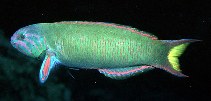| Family: |
Labridae (Wrasses), subfamily: Corinae |
| Max. size: |
45 cm TL (male/unsexed) |
| Environment: |
reef-associated; marine; depth range 1 - 20 m |
| Distribution: |
Indo-Pacific: Red Sea and East Africa (Ref. 4392) to the Line Islands, north to southern Japan, south to Lord Howe Island and northern New Zealand (Ref. 1602). Reported to have formed a hybrid with Thalassoma rueppellii (Ref. 41655). |
| Diagnosis: |
Dorsal spines (total): 8-8; Dorsal soft rays (total): 13-13; Anal spines: 3-3; Anal soft rays: 11-11. Adults are identified by the yellow lunate tail. Large males turn blue on the head that grades to green towards the tail (Ref. 48636). Body dark green to blue with vertical red to purplish red lines. Head green to blue with irregular pink to violet bands. Adults with large yellow crescent posteriorly in caudal fin and blue pectoral fins with a large elongate pink area distally. Juveniles with a large dark spot in middle of dorsal fin and a large diffuse black spot at base of caudal fin (Ref 9823). |
| Biology: |
Occurs solitary or in groups (Ref. 90102) in the upper portions of lagoon and coastal reefs, and in protected seaward reefs (Ref. 1602). Enters estuaries (Ref. 48636). Usually found on upper portions of ledges and heads (Ref. 9710). Feeds mainly on small benthic invertebrates and fish eggs (Ref. 9823). A protogynous hermaphrodite (Ref. 55367). |
| IUCN Red List Status: |
Least Concern (LC); Date assessed: 12 June 2008 Ref. (130435)
|
| Threat to humans: |
harmless |
Source and more info: www.fishbase.org. For personal, classroom, and other internal use only. Not for publication.

